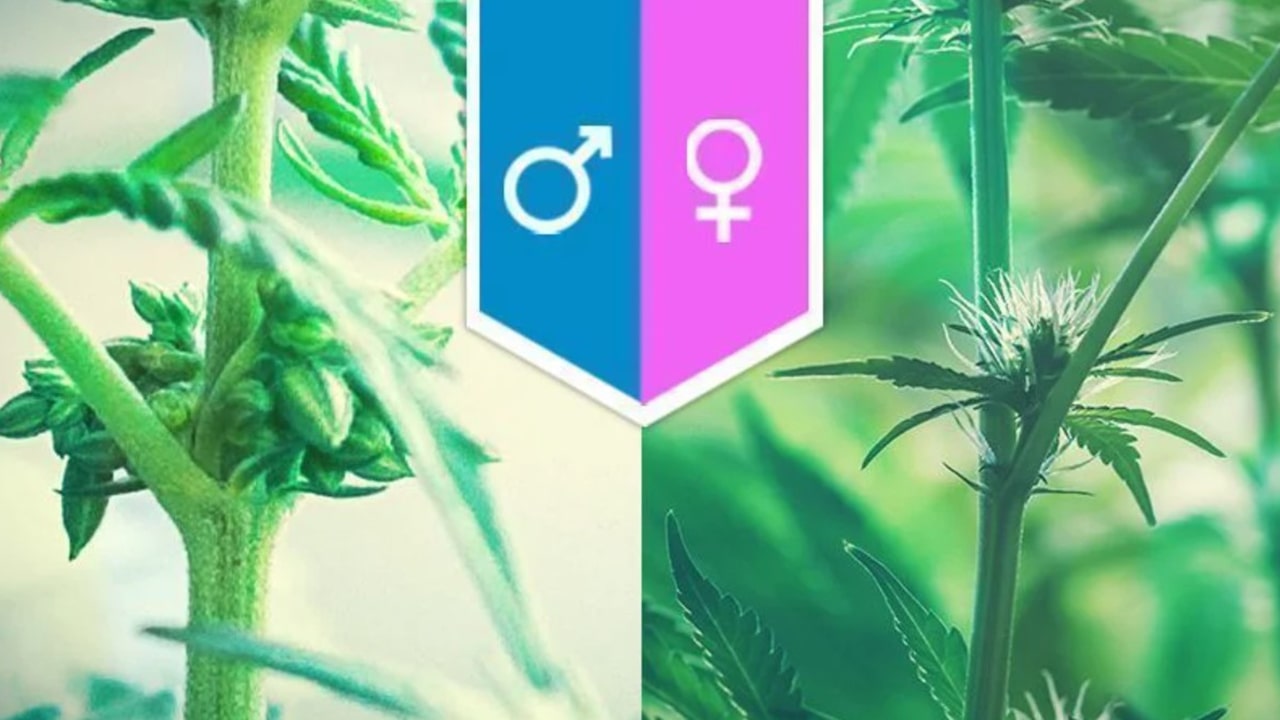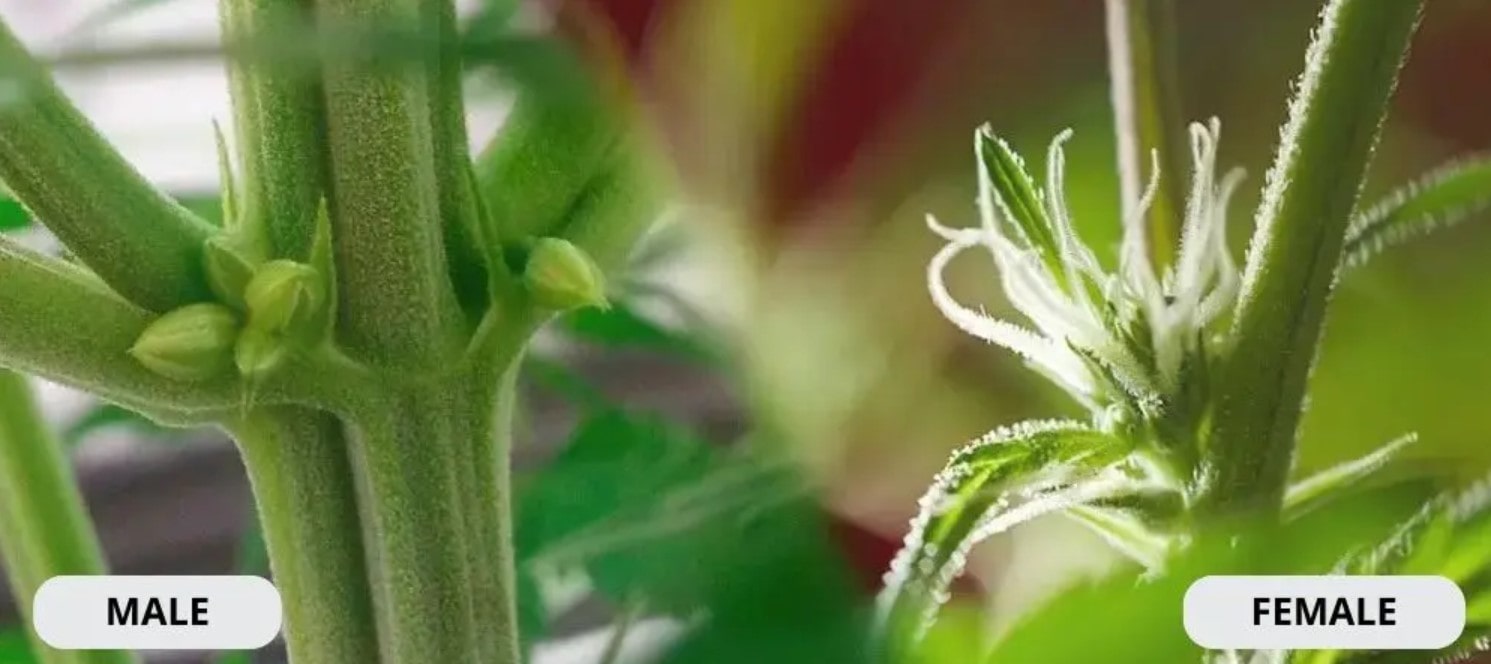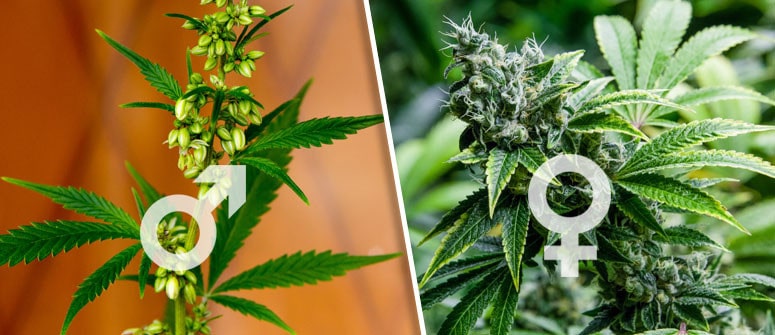
How to determine the gender of a cannabis plant?
One of the key tasks for the novice grower is to learn how to identify the sex of the cannabis plant and understand at what stage of growth the plant should be monitored for signs. In order to produce a quality and abundant crop, it is important to minimize the likelihood of male plants. Feminized cannabis seeds can be a solution to this problem, but they do not guarantee 100% success. When exposed to severe stress or improper care, “femmes” can develop into hermaphrodites.
Before delving into the subtleties, it is worthwhile to understand what exactly differs between female and male plants, as well as why most grovers strive to grow exactly female bushes. Female and male plants differ not only in appearance, but also in chemical composition. These differences are important to keep in mind for every grower who seeks a high and quality crop.

How do I visually identify the sex of cannabis?
When the plants reach maturity, the most noticeable sign of female sex is their compactness. This is especially evident when plants of the same variety are grown under the same conditions. Male plants will be much taller, their leaf cover will be sparse and their internodes will be elongated. This is because their tall shape helps them to spread pollen better. In addition, male plants will have a thicker and stronger central trunk to withstand strong gusts of wind.
It is important to learn how to avoid male plants and not allow them to fertilize female plants. The unfertilized inflorescences, known as sensimilla, contain the maximum concentration of cannabinoids in the resin. While it's always debatable which sex of marijuana is best, it's impossible to do without male plants. However, 95% of growers aim to obtain female plants, while male plants are needed mainly for seed production and breeding work aimed at creating new unique varieties.
Early male and female sex characteristics
The sex of the plant can be determined with high accuracy when the pre-flowers appear - the first visual sexual signs, which are the rudiments of future cannabis inflorescences. In the early stages, these “blossoms” may look similar, but upon closer inspection, the difference becomes apparent.
The sexual traits of female and male plants differ as follows:
- Shape. The male preflower has a smooth, rounded, slightly elongated shape. This is the future staminate flower that will produce pollen for pollination. The female preflorescence, on the other hand, is drop-shaped, strongly elongated, with a fine hair at the end that serves to trap pollen.
- Inflorescence emergence stage. Male preflowers begin to appear after about 3-4 weeks of vegetative growth, whereas female preflowers appear 2-3 weeks later.
These differences allow for timely isolation of male plants before they reach full sexual maturity, resulting in high quality, flavorful sensimilia. The earlier male plants are identified, the less chance of pollination. Cannabis is a highly viable plant and propagation is quick and easy. Partial pollination often occurs even in areas where male plants have been removed. It is not always clear where the pollen may come from, as sometimes the collected buds contain seeds despite isolation efforts.

Figuring out the sex of marijuana in advance
In theory, there are several methods to determine the sex of a cannabis plant even before the first pre-flowers appear. One of them is chemical analysis of tissues, which can reveal a genetic predisposition to male or female. However, this procedure is quite expensive and its accuracy depends on the stage of development of the plant.
If the analysis is carried out after the first week of vegetation, there is a high probability of error. By the third week of vegetative growth, however, the results become as accurate as possible - by this time, male plants begin to show characteristic pre-flowers.
Some growers also claim that it is possible to determine the sex of a plant by scrutinizing the seeds themselves. However, most in the grower community are skeptical of this idea. Considering the shape or size of a seed to be an indication of future sex is more of a folk coincidence or myth than a method that actually works.
How can I get almost 100% female plants?
There are certain methods that allow you to shift the balance slightly towards female plants, although it is still impossible to completely eliminate the risk of “boys”. In mass planting - dozens of bushes - the probability of losing a couple of plants because of their sex is not critical. Even if some of them will show male signs, the remaining ones will provide a decent harvest. But what to do in indore conditions, when only 1-2 plants are planted?
In such a case, it is wise to choose feminized cannabis seeds. Their advantage is the high probability - about 95-97% - to grow female bushes. Provided a stable environment, competent care and lack of stress, the chances of getting the right sex are maximized to 100%. This approach minimizes the element of chance and allows you to focus on growing powerful, productive plants.


